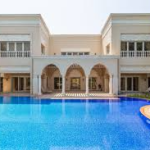Abu Dhabi’s housing market is moving through one of its sharpest transitions in years. In the first half of 2025, the emirate recorded nearly AED 54 billion (≈ USD 14.7 billion) in real estate transactions — about 40 % more than the same period in 2024. Behind that surge is a marked change in what people are buying: villas are outperforming apartments on both price growth and sales momentum.
This trend is most visible in off-plan properties in Abu Dhabi. Developers sold more than AED 22 billion (≈ USD 6 billion) worth of off-plan homes in H1 2025, a large share of which came from villa launches on Saadiyat, Yas and Al Raha Beach. Buyers are willing to commit early to secure land and layouts before completion, betting on future price appreciation and limited supply.
Price Performance Favors Villas
Market data shows a clear gap:
- Villas: Prices have risen about 42 % since early 2020, and continued to climb in 2025.
- Apartments: Appreciation has been notably slower.
In Q2 2025 alone, Abu Dhabi’s average residential price grew 6.4 % quarter-on-quarter, but villas in prime districts outpaced that average. On the rental side, waterfront villa communities have seen 30 %+ rent increases in the past year, while apartment rents rose at a steadier, lower rate.
The price gap is structural: villa supply is limited by land allocation and slower build cycles, while apartments keep entering the market in high numbers, easing price pressure.
Demand Drivers: Space, Scarcity and Investment Logic
The villa segment benefits from three concrete factors:
- Scarce Inventory — New villa plots are tied to long-term master plans; supply can’t expand quickly.
- Higher Land Value — Waterfront and low-density land is finite, making each new release more valuable.
- Investor Math — Capital growth and rental yields (around 6 %+ in some villa districts) outperform apartments, attracting both domestic and overseas buyers.
Developers Respond to the Shift
Government and private developers are adjusting to rising villa demand. In 2025, Abu Dhabi announced 13 new residential districts worth over AED 100 billion (≈ USD 27 billion). Many will include villa communities, but planned supply remains controlled to avoid oversaturation.
Projects are being built in phases, so sales can match demand and prices stay stable. Developers also use flexible payment plans — often 60/40 or 70/30 with post-handover options — making larger homes more accessible while keeping cash flow predictable. New villa districts are planned alongside roads, schools, and amenities to support long-term value.
Market Signals
Transaction data shows a clear shift in activity. Off-plan villa sales now account for a growing share of overall deals, reflecting early demand for low-density housing. Over the past five years, villa prices have outpaced apartment values by roughly 42 %, and rental data confirms the imbalance: waterfront villa leases rose more than 30 % year-on-year in some districts, while apartment rents moved at a slower rate.
The broader market’s 40 % growth in H1 2025 is closely linked to this pattern. Limited land for new villa communities and strong absorption of new launches are shaping both sales and pricing trends.
The Next Phase of Abu Dhabi’s Housing Market
The push toward villas is already influencing the city’s long-term build-out. Authorities announced 13 new residential districts in 2025 with plans for more than 40,000 homes and plots to be rolled out over several years, many of them low-density. So far this year, only about 2,400 units have been completed, while market analysts estimate that more than 11,900 new homes could be delivered by the end of 2025, with a further wave of supply scheduled for 2026.
Even with this pipeline, villa stock is expected to stay tight compared with apartments, keeping pressure on prices and rents. The way the emirate is sequencing these launches shows an intention to sustain demand rather than flood the market, reinforcing the shift toward larger homes as a defining feature of Abu Dhabi’s next growth cycle.








